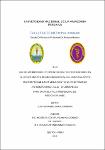| dc.contributor.advisor | Sihuincha Maldonado, Moisés Guido | |
| dc.contributor.advisor | Ramírez García, Edgar Antonio | |
| dc.contributor.author | Coral Panduro, Luis Fernando | |
| dc.date.accessioned | 2018-05-02T18:02:06Z | |
| dc.date.available | 2018-05-02T18:02:06Z | |
| dc.date.issued | 2018 | |
| dc.identifier.uri | http://repositorio.unapiquitos.edu.pe/handle/20.500.12737/5360 | |
| dc.description.abstract | OBJETIVO: Comparar el uso de los antibióticos preoperatorios y postoperatorios en el departamento de Cirugía General del Hospital Apoyo Iquitos “CÉSAR GARAYAR GARCÍA” vs Guías de Manejo Antimicrobiano, Julio a Diciembre 2017.
MATERIALES Y MÉTODOS: Se diseñó un estudio observacional, descriptivo, retrospectivo y transversal, que incluyó todos los paciente intervenidos quirurgicmanete en cirugías abdominales que recibieron antibioticoterapia en el departamento de cirugía general entre Julio – Diciembre 2017. Se obtuvo la información de las historias clínicas a través de una ficha de recolección de datos sobre el uso de antibióticos, que incluye 4 secciones: datos generales de los pacientes, información sobre el procedimiento quirúrgico, información sobre el uso de antibióticos y evaluación de la prescripción del los antibióticos. El adecuado uso de antibióticos se definió según la terapéutica propuesta por “Guía del 2013-2014 de la Organización Panamericana de la Salud” y la “Guía Sanford para la Terapia Antimicrobiana” RESULTADOS: Se analizó a un total de 158 pacientes del servicio de cirugía del hospital Apoyo Iquitos que cumplían los criterios de inclusión. Con una edad promedio de 36.5 ± 18.8 con un mínimo de 1 año y un máximo de 93 años. Siendo 90 (56.97%%) de sexo femenino.
El 93.04% recibió antibióticos, ya sea en el preoperatorio (61.9%), en el postoperatorio
(97.80%) o en ambos (59.86%). Con respecto a las intervenciones quirúrgicas, la colecistectomía y la apendicectomía fueron las más frecuentes con 34.18% y 24.68% respectivamente. Le siguieron en frecuencia la hernioplastía con la LPE con 20.25% y
6.96% respectivamente Solo el 10.25% presentó comorbilidad, siendo la HTA la más frecuente con 8.86% En el preoperatorio el ciprofloxacino resultó ser el antimicrobiano más usado (18.35%), seguido de cefazolina (17.72%), metronidazol (15.19%) y ceftriaxona (15.19%). En el post-operatorio fue la ceftriaxona (41.14%) la más frecuente, seguida de metronidazol (27.85%), ciprofloxacino (27.22) y cefazolina (13.29%) CONCLUSIONES: El uso inadecuado de antibióticos en el departamento de Cirugía es alto, siendo las razones más frecuentes la elección de un esquema inadecuado y una duración incorrecta. | es_PE |
| dc.description.abstract | OBJECTIVE: To compare the use of preoperative and postoperative antibiotics in the
department of General Surgery of the Iquitos Support Hospital “CÉSAR GARAYAR GARCÍA” vs Antimicrobial Management Guidelines, July to December 2017
MATERIALS AND METHODS: An observational, descriptive, retrospective and cross-sectional study was designed, which included all patients surgically treated in abdominal surgeries who received antibiotic therapy in the department of general surgery between July - December 2017. The information of the clinical histories was obtained through a tab of data collection on the use of antibiotics, which includes 4 sections: general data of patients, information on the surgical procedure, information on the use of antibiotics and evaluation of the prescription of antibiotics. The adequate use of antibiotics was defined according to the treatment proposed by the "2013-2014 Guide of the Pan American Health Organization" and the "Sanford Guide for Antimicrobial
Therapy" RESULTS: A total of 158 patients from the surgical service of the Hospital Apoyo Iquitos that met the inclusion criteria were analyzed. With an average age of 36.5 ± 18.8 with a minimum of 1 year and a maximum of 93 years. Being 90 (56.97 %%) of feminine sex. 93.04% received antibiotics, either preoperatively (61.9%), postoperatively (97.80%) or both (59.86%). Regarding surgical interventions, cholecystectomy and appendectomy were the most frequent with 34.18% and 24.68% respectively. Hernioplasty with LPE followed with frequency with 20.25% and 6.96% respectively Only 10.25% presented comorbidity, with HTA being the most frequent with 8.86% In the preoperative period, ciprofloxacin was the most commonly used antimicrobial agent (18.35%), followed by cefazolin (17.72%), metronidazole (15.19%) and ceftriaxone (15.19%). In the post-operative period, ceftriaxone (41.14%) was the most frequent, followed by metronidazole (27.85%), ciprofloxacin (27.22) and cefazolin
(13.29%). CONCLUSIONS: The inappropriate use of antibiotics in the Department of Surgery is high, being the most frequent reasons the choice of an inadequate scheme and an incorrect duration. | en_US |
| dc.description.uri | Tesis | es_PE |
| dc.format | application/pdf | es_PE |
| dc.language.iso | spa | es_PE |
| dc.publisher | Universidad de la Amazonía Peruana | es_PE |
| dc.rights | info:eu-repo/semantics/openAccess | es_PE |
| dc.rights | Attribution-NonCommercial-NoDerivs 3.0 United States | * |
| dc.rights.uri | http://creativecommons.org/licenses/by-nc-nd/3.0/us/ | * |
| dc.source | Universidad Nacional de la Amazonía Peruana | es_PE |
| dc.source | Repositorio institucional - UNAP | es_PE |
| dc.subject | Antibióticos | es_PE |
| dc.subject | Usos | es_PE |
| dc.subject | Profilaxis antibiótica | es_PE |
| dc.subject | Cirugía | es_PE |
| dc.subject | Antibacterianos | es_PE |
| dc.title | Uso de antibióticos preoperatorios y postoperatorios en el departamento de cirugía general del hospital apoyo Iquitos “Cesar Garayar García” vs guías de manejo antimicrobiano, julio – diciembre 2017 | es_PE |
| dc.type | info:eu-repo/semantics/bachelorThesis | es_PE |
| thesis.degree.discipline | Medicina Humana | es_PE |
| thesis.degree.grantor | Universidad Nacional de la Amazonía Peruana. Facultad de Medicina Humana | es_PE |
| thesis.degree.level | Título Profesional | es_PE |
| thesis.degree.name | Médico Cirujano | es_PE |
| thesis.degree.program | Regular | es_PE |
| dc.subject.ocde | http://purl.org/pe-repo/ocde/ford#3.01.05 | es_PE |


